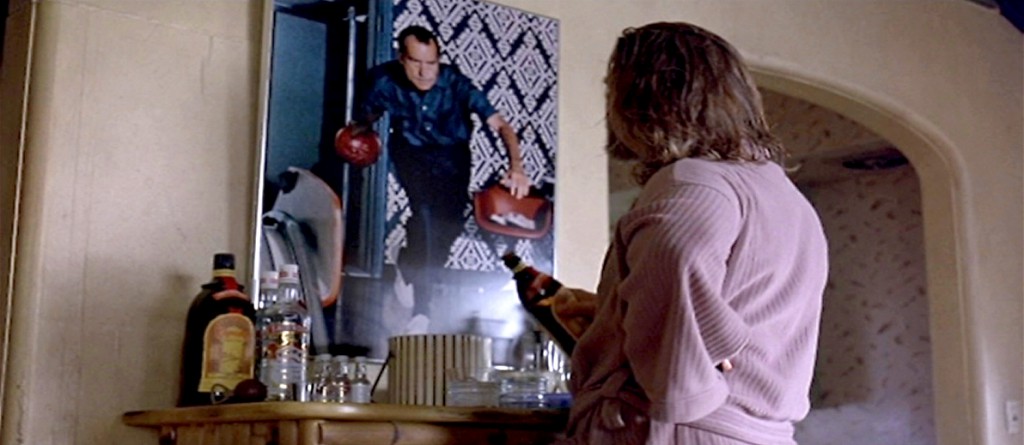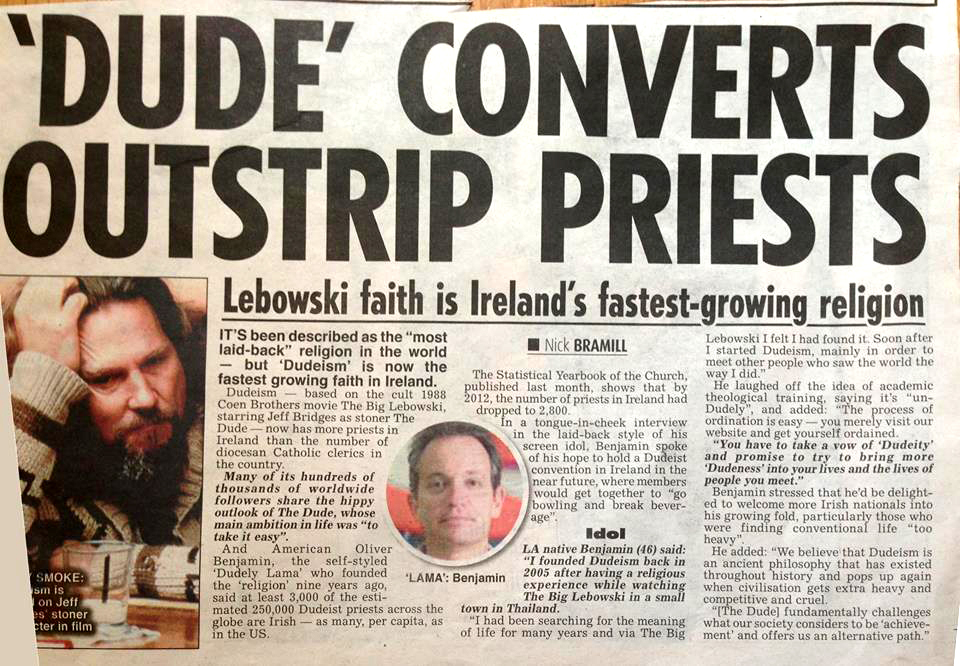Category: music
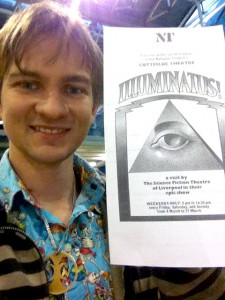
Discordianism is the most influential parody religion you’ve never heard of. However, the half-century old “joke disguised as a religion” is experiencing something of a resurgence, with events such as Daisy Eris Campbell’s Cosmic Trigger play and the ‘Find the Others Festival’ organized by a team of chaotic pranksters including Ben Graham.
Now that chaos is returning to the UK (in style!), I talk to Ben Graham to look back on the long strange journey it’s taken to get here. From the pop sensation that burned a million pounds, to the reclaim the streets movement, Graham tracks chaos from comics to the Cosmic Trigger play.
Chaos culture is coming to you;
here’s where it’s coming from.
In 2015 trend forecaster K-Hole made a bold prediction; the next big thing would be Chaos Magic. To their credit, they seemed to have their finger firmly on the pulse of the zeitgeist—bit by bit, Chaos seemed to start waking up. A sudden resurgence of interest in Discordianism—a chaos worshipping ‘joke religion’—saw multiple book releases from names such as Adam Gorightly and John Higgs. John Higgs also began to do a tour to promote the legacy of famous Discordian author Robert Anton Wilson. Robert Anton Wilson’s family regained copyright to his works and began publishing under the name Hilaritas press. Meanwhile his book Cosmic Trigger (Amazon) was adapted into a play by Daisy Eris Campbell, and a Discordian festival was announced in ‘a south Yorkshire woodland’.
Suddenly, Chaos seemed to be creeping out from nowhere. But of course it hasn’t come from nowhere—in fact, while Anarchy may get all the attention, Chaos in the UK has a long and appropriately complicated history.

Courtesy of Ben Graham.
On a cold evening in London, I spoke to writer Ben Graham, an organizer of Festival 23 and author of A Gathering of Promises: The Battle for Texas’s Psychedelic Music From the 13th Floor Elevators to the Black Angels and Beyond (Amazon), who agreed to guide me through the strange trajectory of British Chaos.
I meet him at a pub up the top of Paddington Station. He has a kind of geeky manner to him, and that delightful British politeness that we see in Hugh Grant movies, shaggy sandy hair framing a friendly face well speckled with rough stubble.
From Magic Manual to Comic Book
Ben starts his tour of the chaotic in his childhood; his first forays into these concepts of chaos came as a child reading comic books. Specifically, a hugely popular series called 2000AD—the series that spawned the character Judge Dredd.

February 26, 1977.
“Basically 2000AD was a British kids comic starting 1977,” he says. “It’s still going today. It started as a fairly kind of violent high-end kids comic with science-fiction themes off the back of Star Wars… it was also a primer in Chaos Magic for a few years there because the guys who were writing it were slipping all this stuff in. Alan Moore, you had Grant Morrison very into it. You also had people who never really got out—like Pat Mills did a comic strip called Slaine which had a lot of Celtic mythology—very into magic ideas. I would have been reading it as a kind of 15/16 year old.”
Grant Morrison, would go on in the late-80s to publish a strip named Zenith, notable for its themes of Chaos Magic. Here, he took influence from Chaos Magician Peter Carroll, the founder of the Chaos Magic organization Illuminates of Thanateros. The inspiration was quite overt—too overt perhaps—at one point Carroll threatened legal action against Morrison.
“You had a kind of a mainstream kids comic where three out of five strips in it would be kind of Chaos Magic primers for kids,” Ben tells me. This early transferal of Chaos Magic ideas from Carrol’s somewhat obscure special interest publications, into mainstream youth popular culture was perhaps one of the first big steps that Chaos took into the mainstream of the British public’s imagination.
Chaos Magic has another notable influence; the ostensibly jocular religion of Discordianism. In his work Oven-Ready Chaos Phil Hine describes this influence:
An important influence on the development of Chaos magic was the writing of Robert Anton Wilson & co, particularly the Discordian Society who revered Eris, the Greek goddess of Chaos. The Discordians pointed out that humor, clowning about and general light-heartedness was conspicuously absent from magic, which had a tendency to become very ‘serious and self-important’. There was (and to a certain extent remains) a tendency for occultists to think of themselves as an initiated ‘elite’ as opposed to the rest of humanity.
Unlike the variety of magical systems which are all based in some mythical or historically-derived past (such as Atlantis, Lemuria, Albion, etc), Chaos magic borrowed freely from Science Fiction, Quantum Physics, and anything else its practitioners chose to. Rather than trying to recover and maintain a tradition that links back to the past (and former glories), Chaos magic is an approach that enables the individual to use anything that s/he thinks is suitable as a temporary belief or symbol system. What matters is the results you get, not the ‘authenticity’ of the system used. So Chaos magic then, is not a system—it utilizes systems and encourages adherents to devise their own, giving magic a truly Postmodernist flavor.
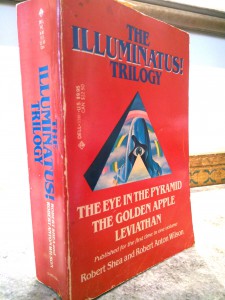
Robert Anton Wilson was himself one of the original Discordians, and is probably single-handedly the person most responsible for the spread of Discordian ideas through the series of books he wrote with his friend Robert Shea—The Illuminatus! Trilogy (Amazon). This strange trilogy featured Discordians fighting against the evil plans of the Illuminati, and proposed that nearly every conspiracy theory popular at the time of writing was simultaneously true.
Epic Productions: Illuminatus! on Stage and the KLF
The event that bought Wilson’s ideas across the pond from the USA was the adaption of his Illuminatus! Trilogy into a play in 1977. Such a feat seemed impossible to do; luckily the discovery of the trilogy came to Ken Campbell; a man who regarded nothing as worth doing unless it was impossible. He was also the father Daisy Eris Campbell, who recently produced the play of Wilson’s book Cosmic Trigger.
Campbell was a theatre legend. His production of Illuminatus! into a play was a testament to his drive and creativity—the final presentation was performed as five acts across five nights, followed by an epic 10 hour presentation of all acts together. The opening date—November 23, 1976—took advantage of the Discordian obsession with the number 23.
As part of Ben’s writing career, he had the opportunity to interview one of the participants in this epic scale caper—Bill Drummond, who had developed the visionary set design of the play, creating surreal sequences with sets out of proportion to the actors, and using innovative techniques to position audiences in surprising ways, such as presenting actors horizontally to allow for a birds eye view of a tarot reading.
“So when I interviewed him, it wasn’t long after Ken Campbell had died,” Ben tells me. “So I wanted to ask him about that. And he was very effusive about the influence Ken Campbell had had on him when he worked on the 1977 production of Illuminatus! at the Liverpool Theatre and how he introduced him to those book and those ideas. Also I didn’t realize that Ken Campbell had been a lifelong friend. He would go to his house, keep in touch, for dinner, stayed like a friend with his family, more or less up to the point where he died. He said he was like a friend, not just a mentor from way back. He’d lost somebody who was an important guiding light.”
“He was always working in the now, he wasn’t thinking in terms of making films, writing books; it was always like, the event, what’s actually happening in the room,” Graham’s 2010 Quietus interview quotes Drummond as saying. “That was one of the big things I learnt from Ken Campbell. And taking risks, and just making things happen. That continued to inspire me about what he does, what he did do, right up until he died. And so I always got a lot out of getting together with Ken Campbell, or going to see a Ken Campbell production.”

Drummond is actually more famous for his role in music than for his role in the Illuminatus! play. He, together with Jimmy Cauty, founded The KLF, a sample based pop outfit. Their original name was The JAMS, a name alluding explicitly to a group in Wilson and Shea’s Illuminatus! Trilogy.
By the time Ben had had his interview, the band had been long broken up. They ended their career in an extraordinary way—by announcing their retirement, shutting down their record catalogue and traveling out to a small island on Jura to burn the money they made—an entire million pounds. (For those interested, aforementioned author John Higgs has brought this strange tale back into the spotlight with his book, The KLF: Chaos, magic and the band who burned a million pounds (Amazon.)
When the band first burned the money, they followed up with a tour where they invited audiences to ‘tell them’ why they burned the money. Ben was in attendance at one of these nights in 1995, and detailed it for his fanzine News From Nowhere.
“They came to Bradford where I was staying and did a showing, a Q&A. I took part in the Q&A, so I had some interaction with the guys but it wasn’t an interview. I did write up the piece. I kind of tied it in with a lot of Discordian Illuminati type thing to sort of put my spin on why they’d done that. It did kind of get back to the KLF chaps, and I gathered that they thought that that was kind of the best piece on it at the time.”
Ben later sends me a copy of it. It is a good piece. The mood of the gathering is palpable, an audience frustrated at being asked questions rather than being given answers, in parts angry, congratulatory and indifferent.
“It was at the One in Twelve Club, Bradford, which was the kind of Anarchist underground club there, so the quotes from the people watching it were that these were kind of rich pop-stars that were burning money that could have gone to a good cause—that it was kind of an indulgent, decadent act. The guys, when they were talking, they weren’t really trying to defend themselves. Their approach was that they were trying to say, ‘we’re trying to find out why we did it, you tell us why we did it, we want to hear your stories,’ so they were being a bit of a kind of blank canvas.”
At one point Graham describes some of the outbursts of the crowd, describing the reaction of a group of punks unhappy that no explanation would be forthcoming.
“How do you get rid of piles,” they demand, amidst assorted jeers and heckles.
“Grab ‘em in your hand, right, and shove ‘em back up yer arse and hold ‘em there,” demonstrates Bill.
“It was a hostile night for them I think at the One in Twelve. My take on it; I suppose I kind of thought that one thing—it was their money. People have wasted that amount of money, music people have made that amount of money and wasted it on far more frivolous things, not many people give it to a charitable cause—they spend it on cars, houses, drugs, whatever with that money. They chose to make an art project by burning it. And I think it was quite a good reaction, they did make people think about the notion of money, money is the relationship between the paper and whatever it is you value in the world.”
His article also quotes the following passage from The Illuminatus! Trilogy:
“And you know what they do with Federal Reserve notes. Every time they get one, they burn it. Instant demurrage, they call it.”
“I doubt that it’s literal that they kind of saw this reference in the book and either it gave them the idea or said that it justifies that. You know, it’s not like the Bible where you’re looking for quotes to justify or base your actions on. But I think the action of doing that was sort of in line with the ideas that came from Discordia and the Illuminatus!…”
“And the burning of the money—it is a random act in the sense that they—they sort of knew why they were doing it I think, but you don’t really know what the consequences are going to be. You know you’re taking this money and you’re burning it and it’s a big—it’s sort of a magical ritual. In that way I think it’s very much a Discordian thing to do. And they deleted their back catalogue. Seemed sort of very much, let’s destroy the idea of the KLF but also you’re sort of creating more of a myth you know, beyond the sort of money making, the actuality of the music business, actuality of the KLF—you’re actually furthering its mythical life.”
At one point in the article Graham quotes one of the pair saying they weren’t trying to make a big statement like “chopping off our hands or something.” The joke would have been lost on the audience—Bill publicly admitted seriously considering that mad idea in his book 45, released in 2000.
One interesting point made towards the end of the article is Graham quoting Bill talking about a gender divide; men were more likely than women to support the burning.
Temporary Autonomous Zones and Radical Rave Culture
“After the KLF, some of the Illuminati stuff did spread into more general rave culture for a few years when it was in its peak,” Graham tells me. He pronounces it Illumin-ar-tai. “Kind of in the early-90s people kind of talked on—sort of around ’87, ’88 but then it went more widespread. It was also in that period when you had in the UK, the kind of club, the rave sort of techno clubs crossed over with the older traveling free festival scene that sort of came with the guy in the 60s and 70s, Hawkwind, that had been traveling hippy dreadlocked guys, because of the ravers that had been having free festivals out in fields, they ended up teaming up with guys who’d been having hippy rock festivals in fields forever. Those guys ended up getting into a lot of techno music, but they would have been guys who were reading the Illuminatus! books in the early 70s. It had the whole kind of esoteric hippy knowledge and stuff behind it, and guys who’d been living outside society for like a decade or so, going around in buses and all sorts of stuff.”
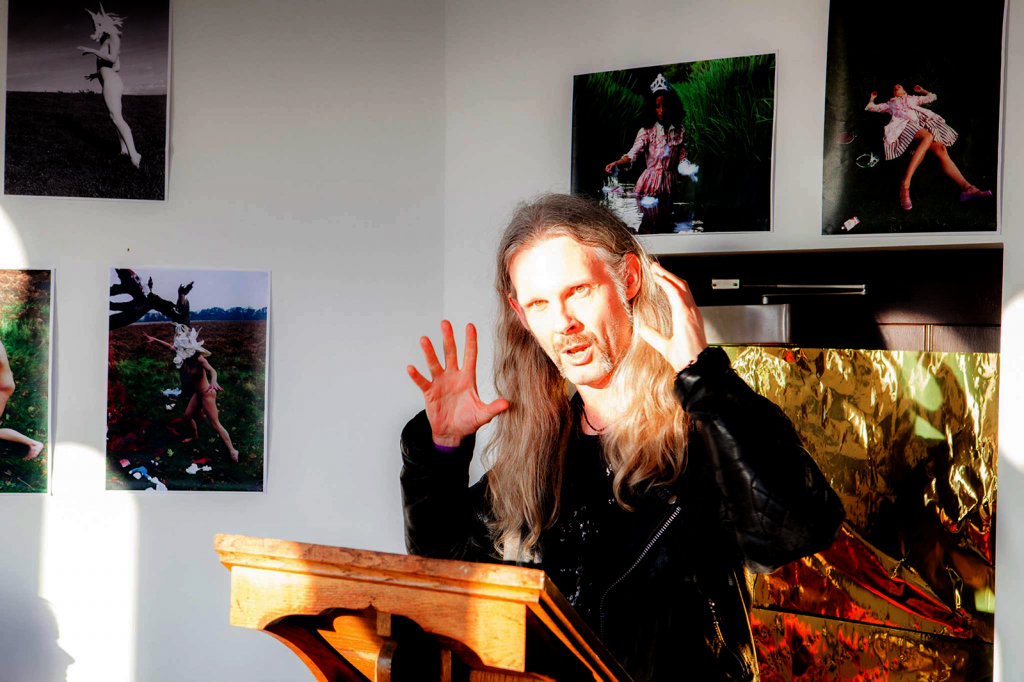
Courtesy of Ben Graham.
“I don’t know how much you know about this stuff; the whole peace bus in the UK, the battle of the Beanfield at Stonehenge where police smashed up, destroyed buses and a whole community, then you had the Castlemorton Festival which led to the Criminal Justice Bill which is a law in the UK outlawing repetitive beats in public places which basically killed the outdoor bass scene. But when you had that whole scene going in the 90s, you had the club rave kids meeting the hippy travelers, one side being electronic techno music and ecstasy, and the other bringing this kind of like hippy philosophy and ethos and knowledge and it all kind of crossing over. And certainly I think a lot of the kind of Illuminati ideas. Suddenly it became cliché to be referencing the number 23 and something, for one thing.”
I mention to Ben the prevalence of the concept of the Temporary Autonomous Zone, in the rave scene. This idea came from Hakim Bey, a philosopher, who described this concept of a space in which the usual laws did not apply in his 1991 book of the same name.
“Yeah,” says Ben. “And in practical terms that sort of crossed over into the reclaim the streets movement doesn’t it. What they were doing certainly kind of early on, there was a lot of theory behind it and the notion of Temporary Autonomous Zone was very much to do with what they were doing, going into the business area of London and having a big party and stopping the traffic. It wasn’t really a protest. Maybe a protest against business or car culture or whatever but at the same time it was the notion of the Temporary Autonomous Zone. It’s like the Situationist idea of beneath the pavements, the beach and in the heart of the city we can have a party, we can bring flowers, we can have a fete in the middle of the road, and that came out of that sort of politicized and radicalized rave culture. You know, they became the reclaim the streets movement and the anti-road protesters, it’s really the same people who’ve moved on from music just into protesting. They’re outdoors and they’re reclaiming their environment, on a kind of Utopian Situationist principle.”
He describes the recent Occupy as a natural outgrowth of reclaim the streets movement.
“It’s like William Burroughs says,” he tells me. “Artists legislate the world, they’re more powerful than politicians because artists create ideas and politicians just put things into action; good artists come up with something new and put it into the world and that kind of changes things.”
Ben Graham has joined forces with a number of other co-conspirators to be part of a contemporary Discordian celebration—Festival 23—that in part formed itself through the energies of the motley crew that came together for the ‘Conferestival’ that marked Daisy Eris Campbell’s opening of Cosmic Trigger. Festival 23 hosted a giant artwork by Jimmy Cauty—an industrial container filled with an epic post-riot miniature landscape. Ben Graham provided the writing on a leaflet that accompanied the artwork:
Both festivals and riots aspire towards freedom; both ultimately are only temporary negations of a stultifying status quo, but may lead to more long-term solutions catalysed by their unfettered expression of energy, anger, love and/or ecstasy. There is freedom in the heart of a riot; a wild abandon and a sense that suddenly anything is possible. Do what thou wilt is quite literally the whole of the law, for the law as defined by policemen, judges and politicians is shown to have no empirical natural authority. It is an assumed condition imposed by those temporarily in power, and can be overthrown both within and without by the will of the people, if only for a limited time and space. But if it can be done once, even for a few seconds, can such glorious lawlessness not be achieved again?
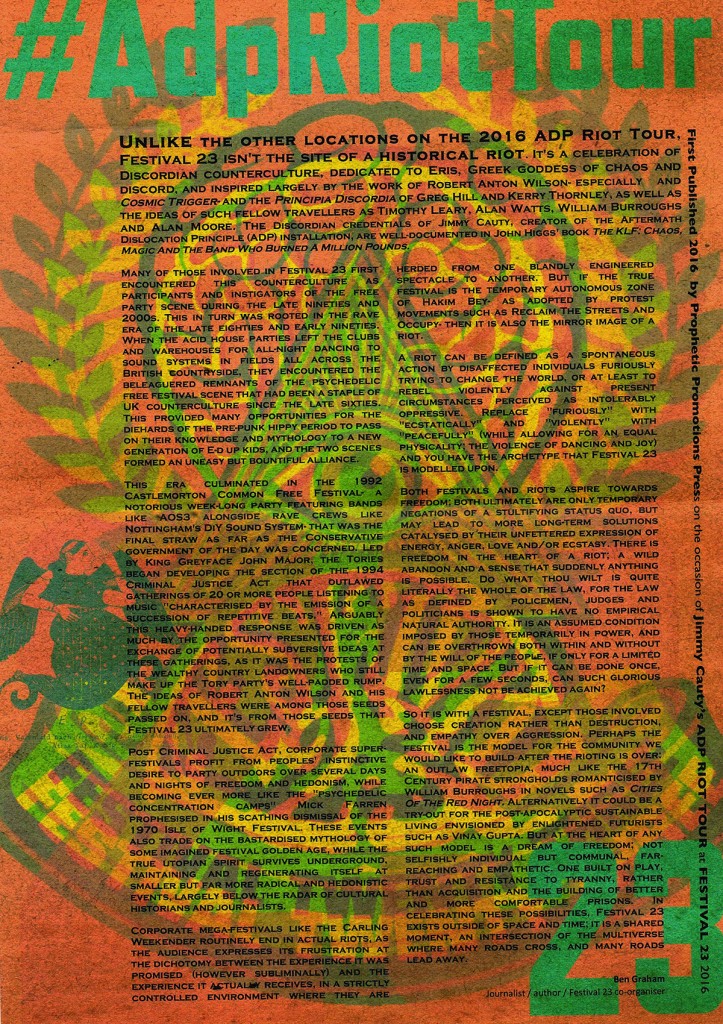
Courtesy of Ben Graham.
So did chaos jump from magic manual to comic book, find itself in fiction, transferred to stage before implanting itself in the minds of future pop superstars, whose rave hits implanted it into the culture of rave, and ultimately protest and party culture?
Well, of course not—such a story is far too clean for the messy madness that is chaos. But if there’s a lesson here, it’s that every strange step of history sets off another twenty-three steps in all sorts of directions. With so many chaotic steps bouncing off each other, how long do you think it will be before you too have the pleasure of being plunged into chaos?
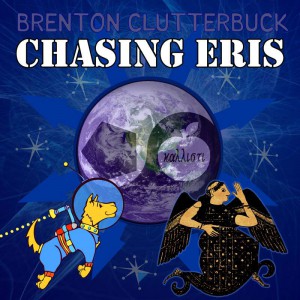
My forthcoming book Chasing Eris will be released next month. The book documents my worldwide adventure to experience modern Discordian culture, meet its personalities, and the discovery of many elusive Erisian mysteries.
—Brenton Clutterbuck
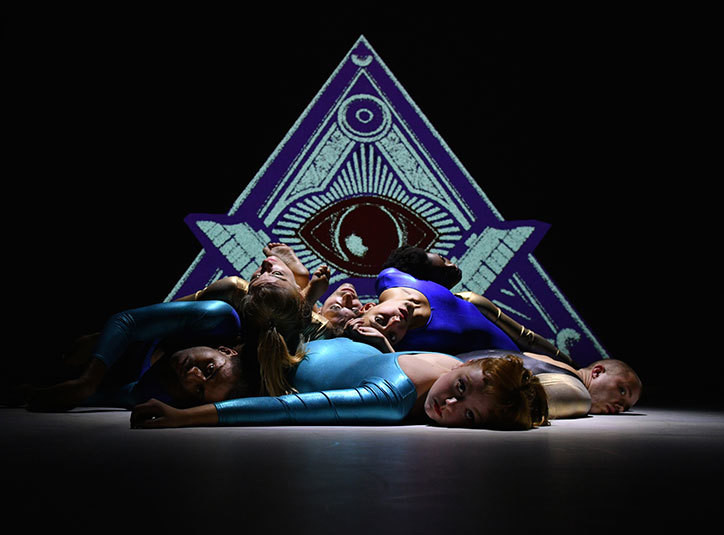
Keep Calm and Ewige Blumenkraft.
Had I only known (when I talked to him a couple months ago) that Adam Curtis was working on a project about the dreaded Illuminati, I most certainly would have interrogated him on the matter! What other secrets is he concealing???
According to Judith Mackrell in the April 21, 2017 edition of The Guardian:
“Against a rising tide of fake news and conspiracy theories, choreographer Rosie Kay and film-maker Adam Curtis have found a timely subject for their new collaboration, MK Ultra. Splicing together documentary footage and a pumped-up stream of dance and music, this two-hour work tells the story of how a generation of under-25s have come to believe in the Illuminati, a shadowy cult they say is attempting world domination through mass brainwashing.
“According to popular myth, the cult operates by grooming targeted individuals to become celebrities, using pop stars such as Britney Spears to disseminate the cult’s agenda through the content of their songs and videos. MK Ultra is an exceptionally stylish production. Illuminati imagery percolates through every aspect of its design, from the pyramid-shaped film screen to the arcane symbols that decorate the seven dancers’ costumes.
“Curtis’s documentary uses a characteristically sophisticated blend of contemporary interview and archive footage to narrate the rise of the Illuminati myth, while Kay’s choreography portrays a group of dancers who have apparently been signed up to the Illuminati programme, drilling themselves for stardom through a relentlessly competitive (and cleverly parodic) regime of twerking, urban, sexy moves.”
So if you’re lucky enough to be in the UK this month, you can totally get your Eye in the Pyramid groove on by attending both MK Ultra and the Cosmic Trigger Play at The Cockpit in London.
In addition, there will be an extended Cosmic Trigger Play extravaganza on May 27th including talks by Alan Moore and Adam Curtis. Find out more here.


"Hail Eris. All Hail Discordia."
Where Circus was pretty cheesy and sensational, CREEM stood out as a mag with a certain gonzo journalistic ethos (“Boy Howdy!”) serving as stomping grounds for perhaps my favorite all time rock critic, none other than Lester Bangs whose reviews I didn’t always agree with, yet his writing was always top-notch-in-your-face-tell-it-like-it-is brilliance of the gonzo variety—like a Hunter Thompson, so to speak, of rock criticism.
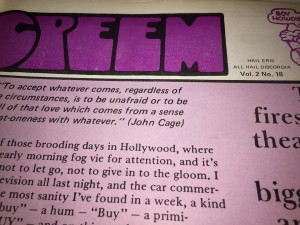
However—until just a few days ago—I was unaware of CREEM’s association with the Discordian Society, which was revealed to me by facebook friend George Sipple, who recently picked up a copy of the December 1970 issue of CREEM mainly for a Lester Bangs article and discovered “Hail Eris! All Hail Discordia!” on the inside cover page.

and Be Happy.
According to John F. Carr, the following list of Discordian Holidays were part of a non-fiction work entitled How to Have Fun and Be Happy that Camden Benares wrote sensing a strong need for such a work.
Unfortunately, his agent was never able to sell it.
—Adam Gorightly
Fun Friday
Fun Friday occurs four times each year. In any month that has five Fridays, the fifth Friday is Fun Friday, the symbolic anniversary of the day that Eris decided everyone should have more fun. This holiday is celebrated by doing anything that creates more fun for all.
JANUARY HOLIDAYS
1-1, Bogey’s Day
This anniversary of the birthday of Humphrey Bogart is celebrated by watching any of the 75 films in which he appeared.
1-5, Carioca Lodge Day
This is the anniversary of the founding of the Discordian Carioca Lodge in Rio de Janiero by the Portuguese Camho family and the Chinese Ho family. It is celebrated by eating Portuguese, Chinese, and Brazilian food, listening to Brazilian music, and watching Brazilian movies.
1-15, St. Afrodite’s Day
This is the day Discordians remember Aphrodite, the Greek goddess who became a Discordian saint when she transformed herself into the black beauty known as St. Afrodite. Celebrations usually include eating soul food and listening to rhythm and blues.
1-23, St. Bobcat’s Day
This is a celebration of the birthday of the son of Fred C. Dobbs and Sara Modrey, the famous Texan Discordian Robert Catman Dobbs, also known as St. Bobcat and the Dealey Lama. St. Bobcat devoted much of his life to aiding unfortunates who joined the Sub Dude cult. Discordians celebrate by saying hello to people named Bob and petting cats.
1-25, Liter Label Lark Day
The repackaging of alcoholic beverages according to the metric system was a Discordian project intended to prevent people from considering consumption of a fifth of liquor to be catma. Discordians who consume alcohol celebrate this day by having one drink. Discordians who don’t consume alcohol celebrate this day with a drink of golden apple juice.
FEBRUARY HOLIDAYS
2-2, Renew Old Acquaintances Day
Discordians celebrate this day by sending greeting cards to old acquaintances they haven’t been in touch with lately.
2-5, Dadanova Day
Dadanova is the famous Discordian art movement. The day is celebrated by creating and sharing art.
2-14, St. Heat’s Day
In remembrance of the great love that Valentine Heart and Valentina Heart had for each other, Discordians spend time having fun with those they love.
2-15, Lupercalia Transmogrified
Lupercalia is an ancient Roman holiday concerned with sex and abundance. Discordians are encouraged to develop their own rituals and ceremonies for this holiday.
2-23, Didyme’s Day
This holiday is in memory of the Dogon-Greek oracle who read tarot cards for Eris. Appropriate ceremonies are those which forecast the future or demystify the present. The following poem by Didyme Thelema’s lover, Asklepiades, is usually read aloud:
Didyme plunders me with her beauty.
When I look at her I am wax over fire.
If she’s black, what of it? So are coals.
When kindled, they glow like blooming roses.
MARCH HOLIDAYS
3-3, Pass Day
This is the day Discordians pass on the things they don’t want. Special celebrations are held in Pasadena, Pascagoula, Pashkovo, Passaic, and Passo Fundo. Some Discordians pass out free cards which read:
F R E E P A S S THIS PASS ENTITLES THE BEARER TO PASS BY ANY OPTIONAL OPPORTUNITIES AT ANY TIME. GOOD FOREVER OR UNTIL NEXT TUESDAY, WHICHEVER COMES FIRST. COURTESY OF THE DISCORDIAN SOCIETY.
3-5, Self-Esteem Day
On this day any Discordian may award herself or himself any honor, degree, or title that seems appropriate.
3-15, Turkey Vulture Day
Discordians celebrate this day by facing toward Hinckley, Ohio, where the turkey vultures roost, and by listening to Simon and Garfunkel’s recording of “El Condor Pasa.”
3-17, Rex Saxonda Film Day
Discordians celebrate by brushing the film off their teeth and watching any motion picture film. Rex believed that every film had value regardless of content.
3-19, St. Swallow’s Day
This is the time for remembrance of St. Swallow who spent years breeding swallows with homing pigeons. The faithful face Capistrano and swallow five times. There is no requirement as to what is to be swallowed. Some skeptics believe that people who celebrate this day will swallow almost anything.
APRIL HOLIDAYS
4-4, Square Day
Discordians celebrate this day by finding fun in the ordinary. Square dancing to Steve Allen’s “Very Square Dance” is encouraged. At least five minutes of television should be watched as part of the celebration.
4-5, Be Kind To Tourists Day
Discordians celebrate this day with random acts of kindness to tourists. Those who find this difficult to do can go some place out of town and pretend to be tourists.
4-15, Break Day
This is the day all Discordians recognize their value and give themselves a well deserved break.
4-29, Duke’s Day
This is Duke Ellington’s birthday, celebrated by listening to, singing along with, or dancing to the music of this American master of music.
MAY HOLIDAYS
5-1, Adam Weishaupt’s Day
 This day is the anniversary of Adam Weishaupt’s founding of the Bavarian Illuminati, rumored to be a front organization for promoting Discordianism. Discordians celebrate by eating Bavarian cake and watching traffic until five autos from the Bavarian Motor Works (BMW) pass.
This day is the anniversary of Adam Weishaupt’s founding of the Bavarian Illuminati, rumored to be a front organization for promoting Discordianism. Discordians celebrate by eating Bavarian cake and watching traffic until five autos from the Bavarian Motor Works (BMW) pass.
5-5, St Gulik’s Day
St. Harvey Gulik, Guardian of the Gentle and Protector of the Harmlessly Weird Ones, is honored on this day. St. Gulik’s familiar was the rabbit so eating a rabbit made from chocolate candy is an appropriate act. Watching the motion picture Harvey, inspired by St. Gulik, is considered an act of devotion.
5-15, Tree Day
Discordian celebrate this day by planting a tree, thinking of five apple trees, or thinking of one apple tree five times.
5-23, Buddha’s Birthday
 Although the evidence that Buddha was a Discordian is circumstantial and anecdotal, Discordians celebrate Buddha’s birthday by saying “Happy Birthday, Bud.” Discordians who are especially devout read aloud from Discordian Zen Buddhist texts such as Zen Without Zen Masters, A Handful of Zen, and Riding Buddha’s Bicycle.
Although the evidence that Buddha was a Discordian is circumstantial and anecdotal, Discordians celebrate Buddha’s birthday by saying “Happy Birthday, Bud.” Discordians who are especially devout read aloud from Discordian Zen Buddhist texts such as Zen Without Zen Masters, A Handful of Zen, and Riding Buddha’s Bicycle.
5-25, Creation Day
This is the anniversary of the Erisian creation of all chaos. Discordians celebrate this day by chanting the Discordian Taoist truth:
“Creation and creator are one; there is no creator separate from creation.”
JUNE HOLIDAYS
6-5, Golden Apple Day
This is the day when each Discordian is entitled to award herself or himself the Golden Apple Achievement Award for outstanding achievement in Discordianism.
6-6, St. Helen’s Day
This is the day that St. Helen of Troy is honored. She apologized to Eris for her unintentional part in the Trojan War and became a Discordian. When last heard from, the reincarnated Helen was working as a waitress at Ships Coffee House where it was said that she had the hips that brought a thousand tips.
6-15, Liberation Day
On this day Discordians remind themselves that their lives are much better since they considered themselves liberated.
6-23, Unknown Saints Day
Since all Discordians are considered saints according to the holy writings of Omar and Malaclypse, this day honors all the Discordians whose names are unknown.
6-25, Know Saints Day
On this day, Discordians honor the other four categories of Discordian saints: living saints, dead saints, fictional saints, and imaginary saints.
JULY HOLIDAYS
7-4, Hodge Podge Lodge Day
This is a celebration of the founding of the first American Discordian lodge by Adam Weishaupt after he fled Bavaria and came to America where he initiated George Washington and later impersonated him. Johnny Appleseed was also initiated by Adam in this lodge. The celebration consists of eating an apple while looking for Discordian symbolism on a one dollar bill.
7-5, Freedom Day
This is the day Discordians celebrate being free of the religious dogma that clogs the pathways of so many brains.
7-7, Mirror Compliment Day
On this day, Discordians look into their mirrors and compliment the mirrors on having the good taste of having such a wonderful, fun-loving owner.
7-14, St. Merde’s Day
This is the day Discordians congratulate themselves on turning the crap of their lives into fertilizer.
7-23, Jack Slack’s Day
Jack Slack is honored this day for his work in guru liberation, liberating gurus from their mistaken beliefs that they are channels for liberation.
AUGUST HOLIDAYS
8-5, St. Otis the Elevated’s Day
On this day Discordians celebrate the elevation of St. Otis by riding in an Otis elevator.
8-8, St. Pythagoras’s Day
St. Pythagoras was fascinated by the number eight. On this day Discordians do eight things that bring more fun for everyone.
8-15, Theatre Night
On this night, Discordians gather at 8:15 before any theatre that has an 8:30 curtain time and entertain those patrons standing in line until they are admitted.
8-23, Nancy Fancymanner’s Birthday
Nancy is remembered by her great contribution to Discordian style. She was the one who said, “Acquiring Discordian style is a matter of individual chaotic subtlety while being fashionable or trendy is merely a willingness to follow herd instinct.”
8-30, St. Scrivener’s Day
On this day Discordian writers are honored by other Discordians who read aloud from published works.
SEPTEMBER HOLIDAYS
9-9, Eris’s Birthday
Discordians celebrate Eris’s birthday on this date because no one is certain what the correct day is. Greek food and golden apples are usually served.
9-17, Emperor Norton’s Day
This is the anniversary of the day in 1859 that San Francisco Discordian Joshua Abraham Norton issued a proclamation declaring himself Emperor of the United States. Discordians celebrate by reading aloud the Emperor’s proclamation which is reprinted here.
PROCLAMATION
At the peremptory request of a large majority of the citizens of these United States, I, Joshua Norton, formerly of Algoa Bay, Cape of Good Hope, and now, for the past nine years and ten months of San Francisco, California declare and proclaim myself Emperor of the United States, and in virtue of the authority thereby in me vested do hereby order and direct the representatives of the different States of the Union to assemble in the Musical Hall of this city on the first day of February next, then and there to make such alterations in the existing laws of the Union as may ameliorate the evils under which the country is laboring, and thereby cause confidence to exist, both at home and abroad in our stability and integrity.
Norton I, Emperor of the United States
9-23, Dog Star Day
On this day, Discordians celebrate the existence of Sirius, the Dog Star, legendary home of the Nommos, space travelers who visited this planet before the Trojan War. This holiday may be celebrated in five ways:
- Eating a hot dog
- Looking at a dogwood tree
- Singing any song with dog in the lyrics
- Petting a dog
- Telling shaggy dog stories
9-25, Erotic Terrorism Prevention Day
This day marks the founding of the Erotic Terrorism Protection League by Felix Pendragon. Erotic terrorism is defined as activity related to sex for the purpose of scaring one or more bystanders or observers. On this day Discordians expand their knowledge of sex to protect themselves from erotic terrorism. One method is to read the following poem by Felix Pendragon:
THE ABC’S OF EROTIC
TERRORISM PROTECTIONAutoeroticism is sex for one.
Brothels charge money for all sexual fun.
Condoms for safe sex are a must.
Dirty pictures show people in lust.
Exhibitionism is showing it all.
Fetishism is weirdness having a ball.
Genital identification is hard to fake.
Hedonism is sex for pleasure’s sake.
Inhibition is what you can lose.
Jailbait is someone too young to choose.
Kinky people to strange sex aspire.
Libido is a name for sexual desire.
Masturbation remains the safest sex play.
Narcissists love themselves in every way.
Obscenity is in the mind of the beholder.
Puberty comes as a child grows older.
Quckie is sex done in a hurry.
Randy is horny to the point of worry.
Satyr is a male who can’t say no.
Tart is a female ready to go.
Uprighters have sex while they stand.
Voyeurs think sex watching is grand.
Yodeling is much more oral than not.
Zoophiles find animals make them hot.
9-30, Kokomo Dragonlady’s Day
This day honors Kokomo Dragonlady, the Indian from Indiana, who promotes the safest sex through her mail order organization, Sex Without Partners. Kokomo claims to be a spiritual and perhaps a physical descendent of Johnny Appleseed. She requests that on this day Discordians plant their seeds in her name.
OCTOBER HOLIDAYS
10-5, Inexpensive Gift Day
On this day devout Discordians show self-appreciation by giving themselves an inexpensive gift.
10-10, Hildegarde’s Night
Bewitching Hildegarde was famous for her on-campus tricks, usually performed at night. Discordians tell stories of the sexual escapades of Hildegarde who was famous on ten campuses and captured the heart of Georgia Tech’s most famous student, George P. Burdette.
10-23, Hugo Troy Tutlege, Jr.’s Birthday
Gift’s are optional on this day because Hugo is the richest Discordian in the world. He is honored for financing the liquor liter label lark, the Discordian Street Theater Extravaganza, the Discordian Players Group Spectacular, and the Weird Oral History Organization (WOHO). In person, Hugo is elusive and a bit of a loner. There is no record of him ever having been seen by two people at the same time. The most common thing said about Hugo is, “Hugo was here. He just left.” This day may not be Hugo’s actual birthday but is derived from his favorite verse of his favorite song, “Chisholm Trail,” namely:
I started up the trail October twenty third
And I throwed my rope in a big cow turd.
Come a ti yi youpy, youpy yea, youpy yea
Come a ti yi youpy, youpy yea.
10-31, Discordian Saints Day
Most Discordians use the day to honor their favorite Discordian saints, including themselves.
NOVEMBER HOLIDAYS
11-5, Motion Picture Day
This is the day that Discordians look for both obvious and subtle references to Discordianism in any film they watch.
11-11, St. Yossarian’s Day
Since eleven plus eleven equals twenty two, Yossarian, the military navigator in the book Catch-22 and the film of the same title is honored on this day. When Yossarian realized that war was crazy and that being in a war was driving him insane he became the Discordian Saint of Military Intelligence. Discordians remind themselves on this day that any civilian outranks all military personnel.
11-23, Romance Day
Discordians on this day think romantic thoughts and recall the famous romantic marriage of Zelda Harrington and Felix Pendragon.
11-25, Literary Saints Day
On this day Discordians read aloud incidents of Discordian Saints in fiction and in other works containing fiction disguised as nonfiction.
11-30, Early Lunch Day
This is the day that Discordians eat lunch at 11:30 a.m.
DECEMBER HOLIDAYS
12-1, Rosetta Stone’s Birthday
This is the day Discordians remember St. Rosetta Stone by looking at stones in a rose garden.
12-7, Buddy Darma’s Day
On this day Discordians sing “My Buddy” and look for catma in weird publications.
12-23, Dragon Clan Anniversary Evening
On this evening Discordians recall and celebrate the Dragon Clan’s victory over erotic terrorism forces. Achievements are exaggerated and some lies are told.
12-25, Jay See Fitzdragon’s Birthday
The ideal celebration for this holiday is listening to bootleg recordings of the first Discordian rock band, Jay See and the Disciples of Eris. The rarity of these recordings causes most Discordians to celebrate in some other manner befitting the occasion.
 Inspired by last year’s production of Daisy Campbell’s Cosmic Trigger Play and Find the Others Festival, an intrepid group of Discordians across the pond are crowdsourcing a Disco free-for-all called Festival 23 slated for the weekend of July 23rd, 2016 that is described as “An interactive celebration of literature and the arts; of theatre, playshops and music inspired by the Discordian movement; a society of philosophers, theologians, magicians, scientists, artists, clowns and similar maniacs who are intrigued with Eris, Goddess of Confusion, and with her doings.”
Inspired by last year’s production of Daisy Campbell’s Cosmic Trigger Play and Find the Others Festival, an intrepid group of Discordians across the pond are crowdsourcing a Disco free-for-all called Festival 23 slated for the weekend of July 23rd, 2016 that is described as “An interactive celebration of literature and the arts; of theatre, playshops and music inspired by the Discordian movement; a society of philosophers, theologians, magicians, scientists, artists, clowns and similar maniacs who are intrigued with Eris, Goddess of Confusion, and with her doings.”
One of the organizers of the Festival 23 event recently appeared on the Cult of Nick which you can hear here.
Hear, hear!
Word on the street is that Daisy Campbell and her band of merry misfits will also be involved with Festival 23, all of which will presumably keep the Golden Apple rolling in a positive direction all the way to Santa Cruz, California where Daisy and the troops intend to stage the Cosmic Trigger play in 2017—on July 23rd to be exact—the same date of the annual Robert Anton Wilson Day in Santa Cruz as well as the day when RAW originally pulled the cosmic trigger back in 1973, which is what all this fuss is about.
For more of a tease, read Daisy’s update here.
 To coincide with all these Cosmic Trigger related happenings, the RAW estate has just announced the official launch of its publishing arm Hilartius Press and re-release of a whole slew of RAW titles. First out of the chutes will be—you guessed it!—Cosmic Trigger I: The Final Secret of the Illuminati with a brand spanking new intro by John Higgs author of the fabulous Discordian title KLF: Chaos Magic Music Money that if you haven’t read, you really should, and quickly.
To coincide with all these Cosmic Trigger related happenings, the RAW estate has just announced the official launch of its publishing arm Hilartius Press and re-release of a whole slew of RAW titles. First out of the chutes will be—you guessed it!—Cosmic Trigger I: The Final Secret of the Illuminati with a brand spanking new intro by John Higgs author of the fabulous Discordian title KLF: Chaos Magic Music Money that if you haven’t read, you really should, and quickly.
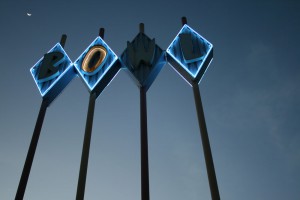
Courtesy Discordian Archives.
Hail Eris! All Hail Dick Weber!
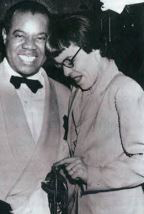
Early Discordian Barbara Reid was a familiar figure in New Orleans bohemia of the 1960s. Known in the French Quarter as “Mother Witch,” she was an avid voodoo practitioner, claiming to have learned the craft from an Orleanian Creole who was a spiritual descendent of Marie Laveau. According to Reid, she was the only Caucasian to whom this knowledge was passed on.00001
Reid worked as a writer and producer for New Orleans television station WDSU and made occasional appearances on local radio, including a 1970 episode of The American Legion Hour on WTIX-AM called “Witches and Metaphysics.” She frequently appeared in newspaper stories, such as a June 1969 Times-Picayune article about Friday the 13th superstitions in which Reid informed the reporter: “I am not a witch, but I’ll show you what a witch can do if you make me out as a kook.”

A Times-Picayune story from September 1964 concerned the closing of Kerry Thornley’s favorite French Quarter hang-out, The Bourbon House. To mark the event, a mock funeral procession was staged, which—along with jazz band accompaniment—included Barbara Reid in a coffin “…clad in her usual all-black garb and sporting a black beret and cigarette holder.”
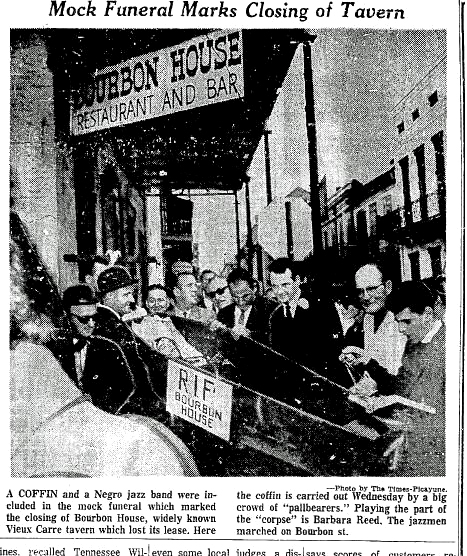
Known for its rag-tag collection of beatniks, poets and jazz music aficionados, many of the Bourbon House regulars—at the urging of Barbara Reid—began staging informal jazz sessions in the early-60s at Larry Borenstein’s art gallery, an institution that would eventually be renamed—and gain international acclaim—as Preservation Hall, the legendary French Quarter music venue still in operation.
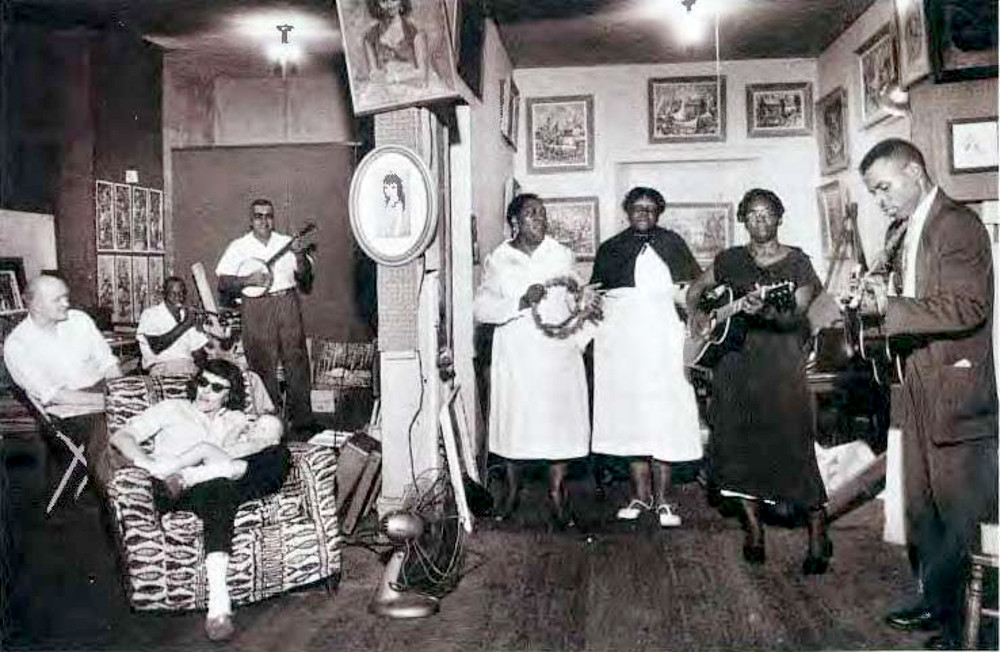
Louisiana Music Magazine, Winter 2012.
Preservation Hall officially opened its doors on June 10th, 1961, an enterprise launched by Reid and her partner in the venture, Kenn Mills. These activities—with Reid at the helm—led to a revival of the traditional jazz scene in New Orleans. However, Reid’s participation in the early days of Preservation Hall has been mostly expunged from the historical records due to a falling out she had with Larry Borenstein, the owner of the venue.
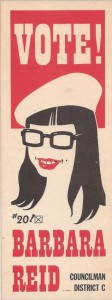
If all that wasn’t enough, Reid was one of the first members of the New Orleans branch of the Discordian Society, claiming at one time or another to be the reincarnation of Goddess Eris herself! Whatever the case, Reid certainly brought a high degree of chaos into Kerry Thornley’s life during the Jim Garrison investigation period when she placed Kerry in the company of Lee Oswald in September of 1963, a couple of months before JFK’s assassination.
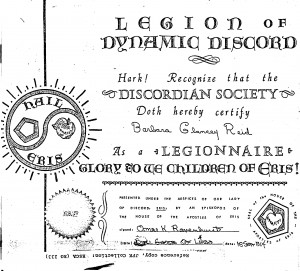
From the House Select Committee on Assassination files, National Archives.
According to Discordian Society co-founder Greg Hill, Barbara Reid was an aspiring politician, pot dealer and former lover of Jim Garrison:
“When Barbara ran for City Council [in 1964], Garrison was absolutely against it and, she told me, repeatedly warned her to stop playing around where she might get hurt. And that, of course, made her all the more anxious to run. I was going to be her Campaign Secretary, but the draft caught up with me and off I went Ft. Polk. When I returned for a day, 8 weeks later, the election was all over with and she placed #3 out of four (not bad, considering). She was pushing for the black vote, and had some kind of lowdown on corruption with the Fed Housing section of the city. She also had the bohemian vote; her posters depicted a caricature of her, all glasses, beret and cigarette holder. It was during this time that she told me that Garrison was an ex-lover of hers and that his warnings to her were as a friend to a friend (though later I got the impression that he was pretty exasperated with her). Like everything else she told me, I didn’t know if I should believe it or not and so, like everything else she did and said, I just enjoyed the circus and didn’t bother believing or disbelieving. I think she said that the affair was sometime ago before Garrison became prominent. She spoke of him with fondness, though annoyed with his not backing her attempted sojourn into city politics.
“I left before Barbara was busted for pot (curiously enough, I felt that the Quarter was being very uncool narc wise, and predicted a giant bust by October—but nobody took me very seriously. I missed the mark by about a month, I think. Many people got it bad, according to what I heard later.). Anyway, she once spoke of not being too concerned with being busted because she ‘could take care of it.’ At the time I wondered if she meant Garrison, but didn’t press the delicate subject…”00002
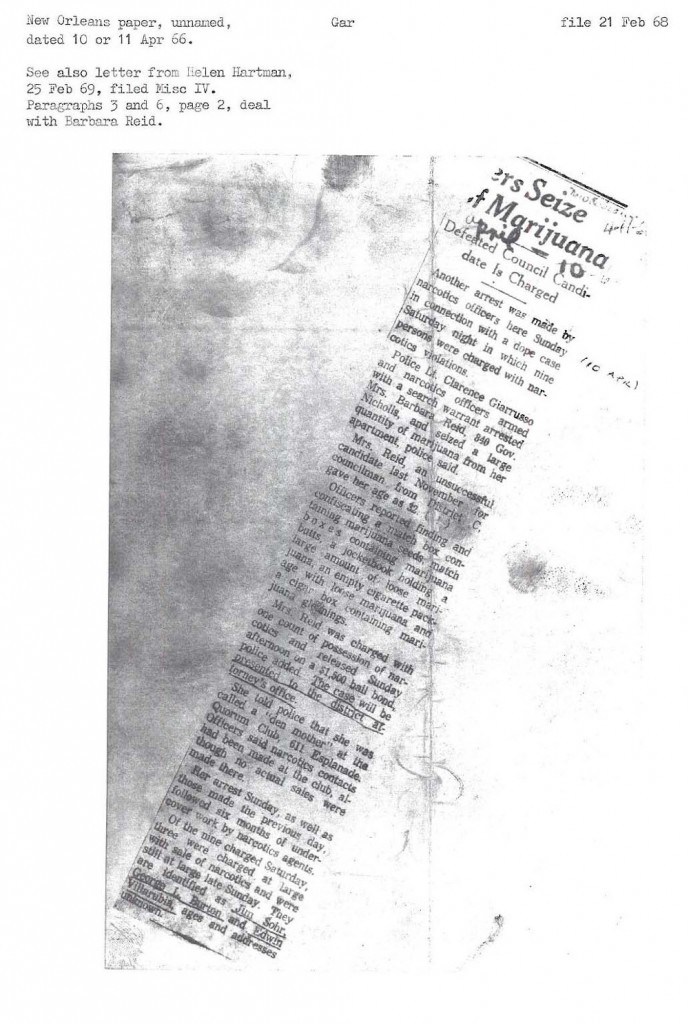
According to the New Orleans States-Item, Reid was arrested on April 10th, 1966 following a six month investigation when narcotics officers seized a large quantity of marijuana from her apartment. Reid—identified as an “unsuccessful candidate last November for District C”—told officers that she was a “den mother” at the Quorum Club, a bohemian coffee house in the French Quarter where she presided over a gaggle of hippie kids. Evidently, the Quorum Club was at the center of this six month investigation. Curiously, Reid’s arrest record for the pot bust identifies her as a “fugitive from Arizona.” These charges were later dropped.
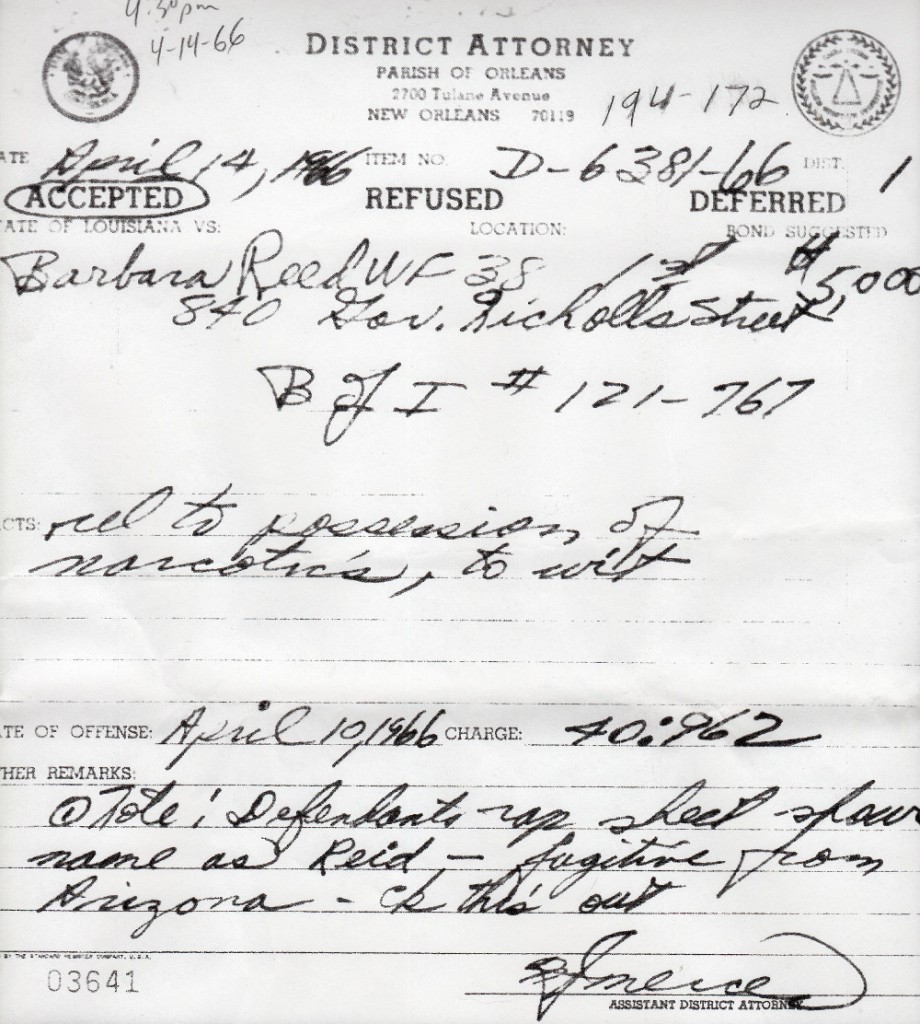
Perhaps what Reid meant by taking “care of it” was that—because of her inside track to Jim Garrison—she could either blackmail or bribe her way out of the charges. Contrary to popular mythology, Garrison was not immune to this type of corruption. In 1970—following a performance by The Grateful Dead at a New Orleans venue called “The Warehouse”—the band’s hotel rooms were raided by police and several members were arrested on drug charges, an incident recounted in their song “Truckin’” and the line: “Busted down on Bourbon Street…”00003 Afterwards, The Grateful Dead tour manager was able to bribe Garrison to take the bust off the records.00004>
In February 1965, Reid was arrested with members of the Hell’s Angels and charged with “bringing the Hell’s Angels to New Orleans.”00005 A February 25th, 1966 New Orleans States-Item article stated that the charges against Reid (identified as “Barbara Reed” in the arrest report) had been dropped, although the four Hell’s Angels “would be held as possible fugitives…”
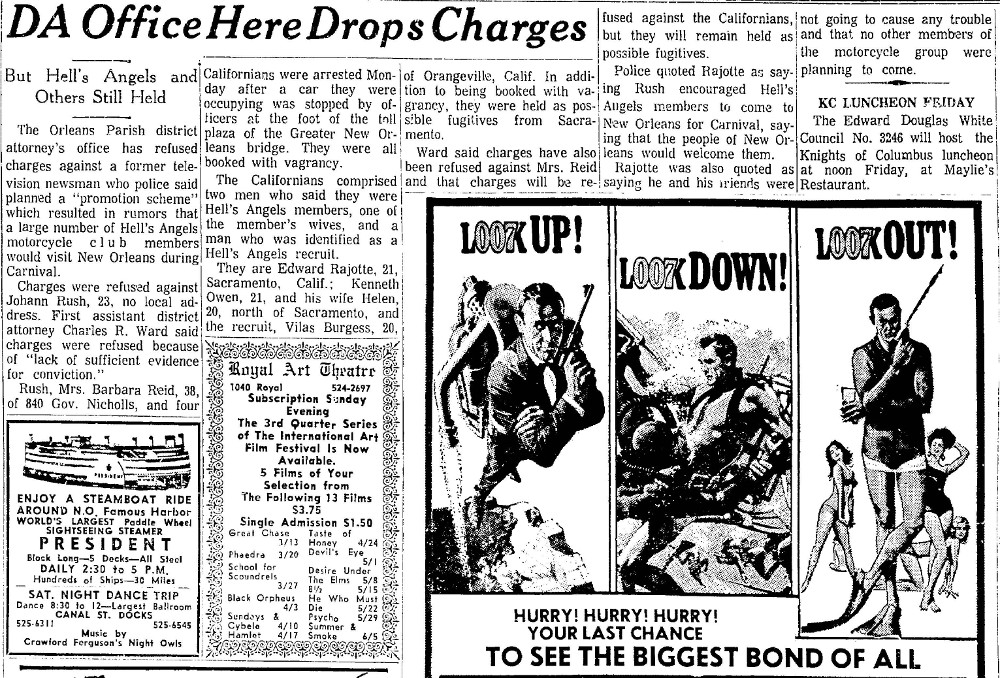
One of Barbara Reid’s more obscure connections involved the Process Church of the Final Judgment, a counterculture cult that emerged in England during the mid-60s of which many dark legends have been spun over the years, first by Ed Sanders in The Family: The Story of Charles Manson’s Dune Buggy Attack Battalion and later by Maury Terry in The Ultimate Evil.
Ed Sanders claimed that The Process Church had a “baleful influence” on Manson and his minions, while Maury Terry alleged that the group was implicated not only in the Tate-LaBianca murders, but the Son of Sam slayings, as well, and that Process Church leadership oversaw a vast Satanic network dealing in drugs, pornography and ritual murder.
In Love, Sex, Fear, Death: The Inside Story of the Process Church of the Final Judgment, ex-Process member Timothy Wylie paints a more benign portrait, stripping away the conspiratorial legends and revealing a group of sincere searchers ultimately manipulated by their charismatic leader, Mary Ann de Grimston.
In correspondence with this author, Kerry Thornley wrote that he “…first encountered the Process Church in New Orleans in Feb. ’68 when I was there to testify, reluctantly, to the Grand Jury. Barbara Reid, the principal witness against me, and a friend (!) of mine, was said to be ‘up to her ass’ in The Process, which, indeed, maintained a coffee house half a block from Barbara’s apartment. I went over there with Slim (Brooks)… and saw pamphlets about Satan On War and Lucifer on War and Jehovah on War—which I found confusing because I thought Satan and Lucifer were both the same guy, until then, (of course—heh-heh)… A bunch of pale, thin zombies were sitting around in this place. I was telling very funny Garrison stories but nobody was laughing…”

To read the whole crazy story pick up my book Caught In The Crossfire: Kerry Thornley, Lee Oswald and the Garrison Investigation (Amazon) while supplies last!
Thanks to Tim Cridland for unearthing many of the materials used in this post.
Read Part 2 of this series here.
00001 “Some Recollections On Barbara Reid” by Greg Hill, 1968. (Greg Hill’s Discordian Archives.)
00002 Ibid.
00003 Lesh, Phil, Searching for the Sound: My Life with the Grateful Dead. Little, Brown and Company, 2005.
00004 Classic Albums: The Grateful Dead – Anthem To Beauty, Isis Productions, 1997.
00005 New Orleans magazine, June 2004.

In 1994 Bill Drummond and Jimmy Cauty took a million pounds to a deserted boathouse on the island of Jura and burnt it. The writer JMR Higgs looked at this event from a magickal perspective and came up with some interesting results. The story involves the world’s first joke religion, the JFK assasination, Robert Anton Wilson, Alan Moore and a bunch of ideas collectively known as “Chaos Magick”.

“No Muse-poet grows conscious of the Muse except by experience of a woman in whom the Goddess is to some degree resident; just as no Apollonian poet can perform his proper function unless he lives under a monarchy or a quasi-monarchy. A Muse-poet falls in love, absolutely, and his true love is for him the embodiment of the Muse…
But the real, perpetually obsessed Muse-poet distinguishes between the Goddess as manifest in the supreme power, glory, wisdom, and love of woman, and the individual woman whom the Goddess may make her instrument…
The Goddess abides; and perhaps he will again have knowledge of her through his experience of another woman…”
—Robert Graves, The White Goddess
Robert Graves—in the above passage—was obviously referring to Eris, although he tried to sugar coat the whole thing to make it appear as if our Lady of Perpetual Chaos is all sweetness and light, which is totally missing the point. Or as Eris herself once said in a certain SoCal bowling alley:
I have come to tell you that you are free. Many ages ago, my consciousness left man, that he might develop himself. I return to find this development approaching completion, but hindered by fear and by misunderstanding. You have built for yourselves psychic suits of armor, and clad in them, your vision is restricted, your movements are clumsy and painful, your skin is bruised, and your spirit is broiled in the sun. I am chaos. I am the substance from which your artists and scientists build rhythms. I am the spirit with which your children and clowns laugh in happy anarchy. I am chaos. I am alive, and I tell you that you are free.
In The Big Lebowski, the Coen Brothers use the holy bowling alley metaphor to further expound upon the Erisian mythos, featuring Jeff Bridges in his classic role of The Dude, the embodiment of Southern California-cool-Eristic-forces-in-action. The last line he delivers in the film is: “The Dude abides,” which certainly seems a wink and nod to a certain Goddess who also abides—or as a way of saying that the Goddess abides in The Dude.
An erstwhile political activist—fond of White Russians, smoking dope and bowling (but not The Eagles)—The Dude goes with the Erisian flow, unconcerned about paying his rent and, in fact, it appears he has no visible means of support and relies entirely upon the will of Eris to guide his chaotic movements and settle his bills. Here the Dude expounds upon The Eagles:
At the eighteen minute mark in the film we see The Dude’s bowling lane identified as the holy Discordian number 23.
The Erisian forces are then set in motion when a guy named Smokey from the opposing bowling team steps over the line during a league match, which sends Walter (John Goodman) on a tirade; Walter brandishes his gun, aims it at Smokey and screams: “Has the whole world gone crazy?” Some may see Walter as an out of control gun wielding wacko, but in reality he’s channeling the chaotic Erisian forces in an attempt to bring some semblance of real order and sanity to a world gone mad with lane violations.
With all his ups and downs, The Dude always seems to land on his feet (more often than not in slippers… or bowling shoes) which attests to the fact that if you put your trust in Eris (In Goddess We Trust!) then some spectacular shit is bound to happen along the way—or at least you won’t be bored!
Conversely—on the other side of the yin-yang coin (or the Hodge-Podge, have you)—there’s that big meanie Jeffrey Lebowski; a man—due to his fucked-up control freak nature—who is crippled, both literally and karmically; a constricted and conniving sour-pus possessed by The Curse of Greyface.
Thus you have the two competing Lebowski’s, a veritable yin-yang/hodge-podge of counter push pull contrasting styles. First, Jeffrey Lebowski (The Big Lebowski played by David Huddleston) who has employed his wealth and power in an attempt to control others; whereas The Dude, well, you know how he rolls. Or as Sam Elliot (as “The Stranger”) says: “Dude, I like your style” …or something to that effect.
The grey-faced aneristic order the Big Lebowski conjures into existence is a group of nihilist Nazis ne’er-do-wells who attempt to rob The Dude of his Erisian powers. In the final showdown, the nihilists attempt to harness Eris and control chaos, but end up getting their asses handed to them when Walter invokes Goddess and launches a bowling ball (the symbolic Golden Apple) knocking the crap out of one of the nihilists along with chomping off the ear of another. Although a glorious Erisian victory, a casualty is unfortunately suffered during the melee when their buddy Donny (Steve Buscemi) dies of a heart attack. Here is Walter’s moving eulogy for Donny.
Goddess reveals herself in many others ways throughout the course of the film, one of which comes in the form of the Big Lebowski’s free spirited and fun loving wife, Bunny, who embodies the trickster spirit of that Great Discordian Saint, Bugs Bunny.
And of course the Goddess manifests in the Big Lebowski’s daughter—Maude (Julianne Moore)—who has rebelled against hers father’s control and chooses The Dude to impregnate her with a magickal child of Chaos; an intentional act to get that old Hodge-Podge-counter-push-pull moving in a positive direction, Eristic vs. Aneristic.
At the 20 minute mark, another deity in the Discordian pantheon appears, none other than his holiness Richard Milhous Nixon shown in full stride as he prepares to roll a Kallisti-inscribed bowling ball into the dark, savage heart of the American dream. Just one more among many apparent Discordian winks and nods imbedded in The Big Lebowski.
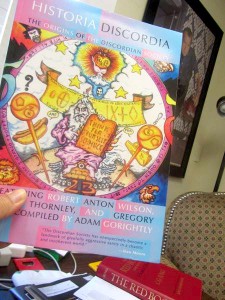 I must also mention another Nixon-related synchronicity that occurred not long ago when Andrew West Griffin of the Red Dirt Report tweeted a pic of Historia Discordia: The Origins of the Discordian Society with the very same Tricky Dick image in the background. And if that wasn’t enough, on Andrew’s table rested a copy of Jung’s Red Book—another stone-cold synchronicity which I probably shouldn’t need to explain.
I must also mention another Nixon-related synchronicity that occurred not long ago when Andrew West Griffin of the Red Dirt Report tweeted a pic of Historia Discordia: The Origins of the Discordian Society with the very same Tricky Dick image in the background. And if that wasn’t enough, on Andrew’s table rested a copy of Jung’s Red Book—another stone-cold synchronicity which I probably shouldn’t need to explain.
When I asked if he’d intentionally placed the Nixon bowling photo in his Historia Discordia pic—or Jung’s Red Book, for that matter—Andrew replied it’d happened by pure dumb luck, which once again confirms the spirit of Eris busy at work directing human affairs and simultaneously blowing our brains.
If all of this wasn’t enough, I just recently discovered a religion dedicated exclusively to The Dude called The Church of the Latter-Day Dude.
In this regard, it should also be noted there are now more Dudeist Priests in Ireland than Catholic ones. Hail Eris!
Included in the Dudeism iconography is a yin-yang like symbol, which seems also a twist on The Sacred Chao but instead of the Golden Apple yin-yanging the Pentagon you have the bowling ball symbol with finger holes balanced against one another in the cosmic drama of life.

And just like Mal-2 back in the day, The Church of the Latter-Day Dudes likewise issues their own certificates of ordination if you so desire to become a Dudeist Priest.
And now, here’s the greatest musical interlude in… well… musical interlude history:
Eris abides.
Enjoy if you dare!
9/11: A Mega Fnord from Floyd Anderson on Vimeo.
“With this video I had in mind the Sacred Chao and what the reaction to 9/11 did, imposing more order upon society and at the same time being the trigger for a great awakening.
http://discordia.wikia.com/wiki/Sacred_Chao”
—Floyd Anderson



